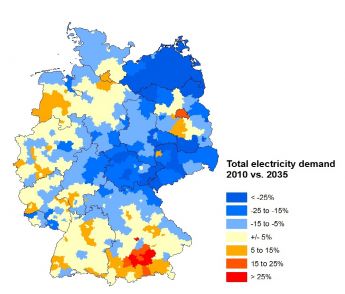FORECAST/eLOAD
-
07.08.2020 Industrial excess heat for district heating: Database shows great potential for supplying households
Excess heat from energy-intensive industries is often suitable for use in district heating systems but is usually unutilized. A detailed overview of the potentials available in the EU is now provided by a database of the sEEnergies project. In Germany, 29 petajoules of excess heat from industrial sites could be used, which corresponds to the demand of more than half a million households. The information is available as maps and downloadable datasets.
The FORECAST model has been extended by a regionalisation approach to assess spatially distributed electricity demand
26.05.2015
A recently published paper describes the extension of the FORECAST model to enable a scenario analysis of spatially distributed electricity demand in Germany for the industry, tertiary, residential and transport sectors until 2035.
A recently published paper describes the extension
of the FORECAST model to enable a scenario analysis of spatially distributed
electricity demand in Germany for the industry, tertiary, residential and
transport sectors until 2035. Developing strategies to deal with the
challenges of the energy system transition requires a detailed grasp of electricity demand on a regional level. This can be provided using the
regionalisation approach that now extends the FORECAST model.
In the paper, the regionalisation model is described and then applied to
analyse the national electricity demand by allocating electricity demand data to
different territorial units.
The
regionalisation model can disaggregate the national electricity demand on a
district (NUTS 3), municipality (LAU 2) or even postal code level. The strength
of the new model is its focus on demand-side sectors and technological heterogeneity,
which allows structural change to be considered on a regional level within a
scenario analysis.
Download
paper here:
© 2024 Fraunhofer ISI | Publishing Notes | Data Protection




